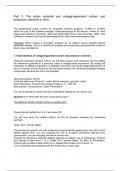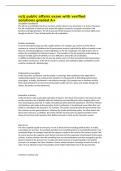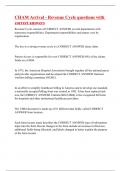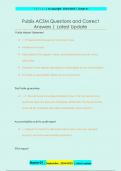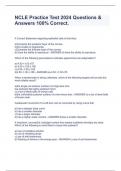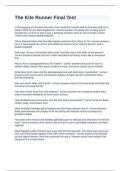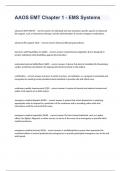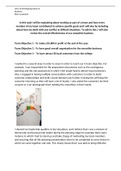Part 2: The action potential and voltage-dependent sodium and
potassium channels in silico
The assignments below concern the simulation software programs VCWIN en CCWIN,
which are part of the software package “Electrophysiology of the Neuron” written by John
Huguenard (Stanford University, USA) and David McCormick (Yale University, USA). This
software is freeware and may be downloaded from ‘https://www.eotnprogram.org/’.
Important: When closing a simulation program do so without saving possibly altered
parameter settings. This is to prevent the program from using the wrong parameter values in
future value calculations!
1. Characteristics of voltage-dependent sodium and potassium channels
Using the simulation program SimVC we will study sodium and potassium flow by holding
the membrane potential at a particular value: a voltage-clamp experiment. By setting the
membrane to different potentials in a stepwise manner we can study voltage-dependence of
the ion channels and ion fluxes (in the real-world situation the membrane potential changes
continuously because the cell is not clamped).
Open the program ‘SimVC’.
In the top right panel “Property”, under “Epoch measure” uncheck “visible”.
Click Parameters, Protocol and change # steps to “1”. Click OK.
Now activate “Conductances” under ‘Parameters.
You will be looking at a panel with the conductance settings for the various ions.
Question 1.1: What does the term conductance mean?
The ability for electric charge to flow in a certain path.
Change the gK setting from 2 to 0 and press OK.
You will now study the isolated sodium ion flux by stepwise changing the membrane
potential.
Under ‘Run’, activate ‘Begin’.
You will see two graphs: one with membrane potential plotted against time, one with current
plotted against time. You are clamping the cell at a higher membrane potential and,
consequently, you are changing the flow of sodium ions.
Change the membrane potential settings stepwise as follows: Go to Parameters, Protocol
and change # steps from 1 to 2. Under Run, activate Begin. Go back to Parameters,
Protocol and increase # steps from 2 to 3. Repeat this process up to # steps = 9.
Try to understand what happens with the sodium flux in each step.
, Question 1.2: Make a I-V curve for sodium channels in which you plot the peak current
against membrane potential. Repeat the stepping protocol described above, it runs from -70
to 65 mV in nine steps of 15 mV each. Read the peak values off of the screen with a ruler or
a piece of paper.
Current_Na = [0 0 -45 -265 -240 -160 -85 -20 50];
Current_K = [0 0 0 30 80 140 190 235 280];
Potential = [-85 -70 -55 -40 -25 -10 5 20 35];
Question 1.3: What direction (positive or negative) does the peak current have at -25 mV?
At this setting, in what direction (inward or outward) do the sodium ions flow through the
membrane? Why is the peak current positive at 65 mV?
I
In your answer, make use of the fact that the ion current, ion , is equal to the ion’s
conductance multiplied by the driving force (the difference between membrane potential and
equilibrium potential):
I ion =g ion (V m−Eion )
gion , the (voltage-dependent) conductance, of sodium
See Purves page 45. In our case,
may have a maximum value of 10 S),
V m is the membrane potential, Eion is the
equilibrium potential or reversal potential of the ion.
potassium channels in silico
The assignments below concern the simulation software programs VCWIN en CCWIN,
which are part of the software package “Electrophysiology of the Neuron” written by John
Huguenard (Stanford University, USA) and David McCormick (Yale University, USA). This
software is freeware and may be downloaded from ‘https://www.eotnprogram.org/’.
Important: When closing a simulation program do so without saving possibly altered
parameter settings. This is to prevent the program from using the wrong parameter values in
future value calculations!
1. Characteristics of voltage-dependent sodium and potassium channels
Using the simulation program SimVC we will study sodium and potassium flow by holding
the membrane potential at a particular value: a voltage-clamp experiment. By setting the
membrane to different potentials in a stepwise manner we can study voltage-dependence of
the ion channels and ion fluxes (in the real-world situation the membrane potential changes
continuously because the cell is not clamped).
Open the program ‘SimVC’.
In the top right panel “Property”, under “Epoch measure” uncheck “visible”.
Click Parameters, Protocol and change # steps to “1”. Click OK.
Now activate “Conductances” under ‘Parameters.
You will be looking at a panel with the conductance settings for the various ions.
Question 1.1: What does the term conductance mean?
The ability for electric charge to flow in a certain path.
Change the gK setting from 2 to 0 and press OK.
You will now study the isolated sodium ion flux by stepwise changing the membrane
potential.
Under ‘Run’, activate ‘Begin’.
You will see two graphs: one with membrane potential plotted against time, one with current
plotted against time. You are clamping the cell at a higher membrane potential and,
consequently, you are changing the flow of sodium ions.
Change the membrane potential settings stepwise as follows: Go to Parameters, Protocol
and change # steps from 1 to 2. Under Run, activate Begin. Go back to Parameters,
Protocol and increase # steps from 2 to 3. Repeat this process up to # steps = 9.
Try to understand what happens with the sodium flux in each step.
, Question 1.2: Make a I-V curve for sodium channels in which you plot the peak current
against membrane potential. Repeat the stepping protocol described above, it runs from -70
to 65 mV in nine steps of 15 mV each. Read the peak values off of the screen with a ruler or
a piece of paper.
Current_Na = [0 0 -45 -265 -240 -160 -85 -20 50];
Current_K = [0 0 0 30 80 140 190 235 280];
Potential = [-85 -70 -55 -40 -25 -10 5 20 35];
Question 1.3: What direction (positive or negative) does the peak current have at -25 mV?
At this setting, in what direction (inward or outward) do the sodium ions flow through the
membrane? Why is the peak current positive at 65 mV?
I
In your answer, make use of the fact that the ion current, ion , is equal to the ion’s
conductance multiplied by the driving force (the difference between membrane potential and
equilibrium potential):
I ion =g ion (V m−Eion )
gion , the (voltage-dependent) conductance, of sodium
See Purves page 45. In our case,
may have a maximum value of 10 S),
V m is the membrane potential, Eion is the
equilibrium potential or reversal potential of the ion.

